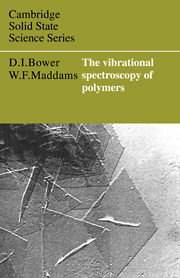Book contents
- Frontmatter
- Contents
- Preface
- 1 Introduction
- 2 Symmetry and normal modes of vibration
- 3 The vibrational modes of polymers
- 4 Infrared and Raman spectra
- 5 The characterization of polymers
- 6 The microstructure of polymers
- References for chapters 5 and 6
- A note on the use of the indexes
- Index of spectra illustrated
- Index of point groups
- Index of group modes
- Index of polymers
- Main index
5 - The characterization of polymers
Published online by Cambridge University Press: 05 May 2010
- Frontmatter
- Contents
- Preface
- 1 Introduction
- 2 Symmetry and normal modes of vibration
- 3 The vibrational modes of polymers
- 4 Infrared and Raman spectra
- 5 The characterization of polymers
- 6 The microstructure of polymers
- References for chapters 5 and 6
- A note on the use of the indexes
- Index of spectra illustrated
- Index of point groups
- Index of group modes
- Index of polymers
- Main index
Summary
Introduction
This chapter is largely concerned with two aspects of the vibrational spectroscopy of polymers. The first of these is the interpretation of spectra, i.e. the assignment of the observed peaks in the infrared and Raman spectra at one or more of the levels listed in subsection 4.3.1, and the second is the application of a knowledge of such assignments to various aspects of the chemical analysis of polymers. Chapter 6 deals with applications aimed at understanding various aspects of the microstructure of the polymer which are generally classed as physical rather than chemical aspects, although the distinction is sometimes rather arbitrary. It should be emphasized that the division of spectral studies into separate phases of ‘interpretation’ and ‘application’ is somewhat artificial, since the two processes often take place side by side. Generally speaking, however, the aims of individual studies will be largely directed towards one or the other of these two aspects of vibrational spectroscopy.
The approach adopted for the interpretation of a particular vibrational spectrum depends upon the nature of the polymer under examination and the information being sought. If the purpose is simply the identification of the polymer, the spectrum is used on a ‘finger-print’ basis; strong peaks are assigned to various chemical groups and detailed assignments in terms of specific vibrational modes are unnecessary. If the objective is the quantitative analysis of a mixture, or of a copolymer, a rather less superficial approach is required.
- Type
- Chapter
- Information
- The Vibrational Spectroscopy of Polymers , pp. 162 - 226Publisher: Cambridge University PressPrint publication year: 1989
- 4
- Cited by



